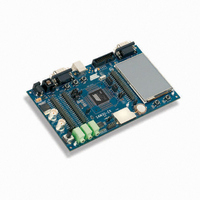ATSAM3U-EK Atmel, ATSAM3U-EK Datasheet - Page 600

ATSAM3U-EK
Manufacturer Part Number
ATSAM3U-EK
Description
KIT EVAL FOR AT91SAM3U CORTEX
Manufacturer
Atmel
Type
MCUr
Datasheets
1.ATSAM3U-EK.pdf
(2 pages)
2.ATSAM3U-EK.pdf
(61 pages)
3.ATSAM3U-EK.pdf
(1171 pages)
4.ATSAM3U-EK.pdf
(53 pages)
Specifications of ATSAM3U-EK
Contents
Board
Processor To Be Evaluated
SAM3U
Data Bus Width
32 bit
Interface Type
RS-232, USB
Operating Supply Voltage
3 V
Silicon Manufacturer
Atmel
Core Architecture
ARM
Core Sub-architecture
Cortex - M3
Silicon Core Number
SAM3U4E
Silicon Family Name
SAM3U
Kit Contents
Board CD Docs
Rohs Compliant
Yes
For Use With/related Products
AT91SAM3U
Lead Free Status / RoHS Status
Lead free / RoHS Compliant
Available stocks
Company
Part Number
Manufacturer
Quantity
Price
Company:
Part Number:
ATSAM3U-EK
Manufacturer:
Atmel
Quantity:
10
- ATSAM3U-EK PDF datasheet
- ATSAM3U-EK PDF datasheet #2
- ATSAM3U-EK PDF datasheet #3
- ATSAM3U-EK PDF datasheet #4
- Current page: 600 of 1171
- Download datasheet (25Mb)
600
600
SAM3U Series
SAM3U Series
nected to other peripherals are in use as well, the SPI DMAC might be delayed by another
(DMAC with a higher priority on the bus). Having DMAC buffers in slower memories like flash
memory or SDRAM compared to fast internal SRAM, may lengthen the reload time of the
SPI_TDR by the DMAC as well. This means that the SPI_TDR might not be reloaded in time to
keep the chip select line low. In this case the chip select line may toggle between data transfer
and according to some SPI Slave devices, the communication might get lost. The use of the
CSAAT bit might be needed.
When the CSAAT bit is set at 0, the NPCS does not rise in all cases between two transfers on
the same peripheral. During a transfer on a Chip Select, the flag TDRE rises as soon as the con-
tent of the SPI_TDR is transferred into the internal shifter. When this flag is detected the
SPI_TDR can be reloaded. If this reload occurs before the end of the current transfer and if the
next transfer is performed on the same chip select as the current transfer, the Chip Select is not
de-asserted between the two transfers. This might lead to difficulties for interfacing with some
serial peripherals requiring the chip select to be de-asserted after each transfer. To facilitate
interfacing with such devices, the Chip Select Register can be programmed with the CSNAAT bit
(Chip Select Not Active After Transfer) at 1. This allows to de-assert systematically the chip
select lines during a time DLYBCS. (The value of the CSNAAT bit is taken into account only if
the CSAAT bit is set at 0 for the same Chip Select).
Figure 32-10
CSNAAT bits.
shows different peripheral deselection cases and the effect of the CSAAT and
6430D–ATARM–25-Mar-11
6430D–ATARM–25-Mar-11
Related parts for ATSAM3U-EK
Image
Part Number
Description
Manufacturer
Datasheet
Request
R

Part Number:
Description:
AT91 ARM Thumb-based Microcontrollers
Manufacturer:
ATMEL [ATMEL Corporation]
Datasheet:

Part Number:
Description:
DEV KIT FOR AVR/AVR32
Manufacturer:
Atmel
Datasheet:

Part Number:
Description:
INTERVAL AND WIPE/WASH WIPER CONTROL IC WITH DELAY
Manufacturer:
ATMEL Corporation
Datasheet:

Part Number:
Description:
Low-Voltage Voice-Switched IC for Hands-Free Operation
Manufacturer:
ATMEL Corporation
Datasheet:

Part Number:
Description:
MONOLITHIC INTEGRATED FEATUREPHONE CIRCUIT
Manufacturer:
ATMEL Corporation
Datasheet:

Part Number:
Description:
AM-FM Receiver IC U4255BM-M
Manufacturer:
ATMEL Corporation
Datasheet:

Part Number:
Description:
Monolithic Integrated Feature Phone Circuit
Manufacturer:
ATMEL Corporation
Datasheet:

Part Number:
Description:
Multistandard Video-IF and Quasi Parallel Sound Processing
Manufacturer:
ATMEL Corporation
Datasheet:

Part Number:
Description:
High-performance EE PLD
Manufacturer:
ATMEL Corporation
Datasheet:

Part Number:
Description:
8-bit Flash Microcontroller
Manufacturer:
ATMEL Corporation
Datasheet:

Part Number:
Description:
2-Wire Serial EEPROM
Manufacturer:
ATMEL Corporation
Datasheet:











